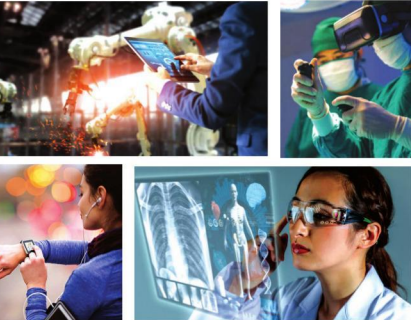The internet as we know today had a humble beginning as a data packet sharing project of the US Defense Advanced Research Projects (DARPA) in 1973. Today it has metamorphosed into a massive decentralized juggernaut that is used to coordinate, collaborate and most importantly control the way in which modern societies transcend borders and languages in communicating and carrying out commerce.
Once human communication became an ubiquitous phenomenon, the next frontier for internet supremacy has been controlling machine communication. The marvel of silicon has already ensured that most mechanical devices and machines have electronic circuits at their heart. With a simple chip connecting the electronics to the internet, now these machines can be controlled from anywhere through smartphone applications. The internet brought families closer where expatriates living at say Boston could communicate regularly with elderly parents at Bangalore through audio and video.
The health and status of electronic devices at their native place located thousands of miles away could be easily probed through Human-toMachine (H2M) communication. Connected devices like smart watch on our wrists can report important health parameters when demanded. Such parameters are also constantly monitored using Machine-toMachine (M2M) communications and any anomaly or deviation from the usual pattern is immediately alerted. In effect slowly such devices are taking control over our lives facilitating smarter choices through Machine-to-Human (M2H) communication, resulting in better quality of life.
Application of such systems range from simple household devices to extremely complicated industrial tools enabling process automation and reduction of manual labor costs.
This network of physical objects or “things” having sensors inside them that can connect to the “internet” for the purpose of transfer of information with other devices, systems or humans is popularly known as “Internet of Things” or IoT. These connected devices are encouraging businesses to redesign their value chain and strategies.
The immediate benefits across domains is access to device information on demand and better synchronization between processes helping in automation. Already segments like those of Utilities and Transports have brought the technology mainstream. Water meters can notify users of leakages and possible contamination.
Electric meters can detect potential line faults and send alerts to the users. In the transport segment, the new-age cars already have such smart sensors fitted inside the cars. A network of such sensors is also helping us to reach the next innovation frontier for the connected cars and smart fleets. These sensors can detect when a particular equipment will fail and can trigger safety measures and alerts in advance. In cold weather, the owner can remotely trigger the heating of the engine before embarking on a journey.
In the agriculture and farming segment, these IoTs help monitor light, temperature, humidity, etc. in the soil with provision for automatic irrigation. In segments like Retail, IoT is used to optimize inventory and reduce wastages. Smart cameras or smart weight panels can sense when the items in the shelves are below a given threshold and trigger reordering.
In the Smart-City for the future world, IoT sensors help conserve energy, send signals when sanitation conditions are poor, alleviate traffic and monitor and address environmental concerns in the city like toxic gasses and pollution.
It has been estimated that by Gartner that Building Automation or Connected building will be the fastest growing segment followed by automotive and healthcare. Some of the technologies that have made IoT efficient, effective, and viable are access to low-cost and low-power sensors, Internet connectivity, Software and Network sensors, Cloud Computing platforms, cyber security and data analytics. Experts in such evolving technologies are still scarce and organizations spend significant efforts in upskilling the workforce.
The slowing electronics industry has got a new area of focus with the focus on manufacturing these sensors so graduates in electronics have much to cheer about. Those who are competent in the area of networking can focus on getting the 5G network in place so that connectivity of such IoT devices can even touch the remotest of villages enabling better healthcare, education and communication. With IoT devices, a lot of data gets generated. The cloud computing ecosystem has been growing rapidly to keep up with the demands so those working in the areas of database management and data engineering have some good time ahead of them.
With a plethora of such devices and data being generated and used to control critical infrastructure, cyber security and surveillance becomes even more important to control the wellbeing of the citizens using these technologies in day to day life. The data generated from such devices can be analyzed for patterns of anomalies and predictions on instances like demand surge, equipment failure can be effectively mitigated using data analytics.
In fact the most sought after practitioners will be those who would be working at the intersection of data analytics and cyber security to give birth to a new breed of cyber analytics professionals. Larger organizations working in the area of agriculture, manufacturing, healthcare, supply chain to environment and public safety are already adopting IoT allowing newer use-cases to surface.
This will encourage medium and smaller businesses to realize the benefits of the technology in enabling cost reduction through automation and manual labor in order to remain competitive. It has been estimated that by 2025, roughly 22 billion IoT devices will be used, while predictions of Tech analyst company IDC pegs this number at 41.6 billion.
With such mass adoption and commercialization of the technology, it is important that organizations encourage skill-building and job creation for this technological marvel whose possible business values are practically limitless. The building blocks for some of these are taught at many Technical Schools but only a few prepare learners’ towards the strategic and financial implications of IoT.
With the evolving technology and business landscapes of the IoT ecosystem, the curriculum is unable to keep pace with the rapid evolution. Practitioners looking at either technology or business aspects in this ecosystem are required to constantly learn on the job and take part in helping the ecosystem evolve. It is imperative that Academia and Industry work together in bridging the skill gap and produce a workforce that is productive and efficient in helping mature the IoT ecosystem.











